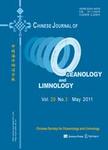Response of cellular stoichiometry and phosphorus storage of the cyanobacteria A phanizomenon flos-aquae to smallscale turbulence
Response of cellular stoichiometry and phosphorus storage of the cyanobacteria A phanizomenon flos-aquae to smallscale turbulence作者机构:CAS Key Laboratory on Reservoir Water EnvironmentChongqing Institute of Green and Intelligent TechnologyChinese Academy of Sciences State Key Laboratory of Bioreactor EngineeringCollege of BiotechnologyEast China University of Science and Technology
出 版 物:《Chinese Journal of Oceanology and Limnology》 (中国海洋湖沼学报(英文版))
年 卷 期:2017年第35卷第6期
页 面:1409-1416页
核心收录:
学科分类:0908[农学-水产] 08[工学] 09[农学] 0815[工学-水利工程]
基 金:Supported by the National Natural Science Foundation of China(Nos.51309220,51679226) the National Key SandT Project on Water Pollution Control and Treatment(Nos.2014ZX07104-006,2015ZX07103-007) the Western Action Program funded by the Chinese Academy of Sciences(No.KZCX2-XB3-14)
主 题:Aphanizomenon flos-aquae cellular stoichiometry photosynthesis polyphosphate turbulent dissipation rate
摘 要:Turbulent mixing, in particular on a small scale, aff ects the growth of microalgae by changing diff usive sublayers and regulating nutrient fluxes of cells. We tested the nutrient flux hypothesis by evaluating the cellular stoichiometry and phosphorus storage of microalgae under dif ferent turbulent mixing conditions. A phanizomenon flos-aquae were cultivated in dif ferent stirring batch reactors with turbulent dissipation rates ranging from 0.001 51 m2/s 3 to 0.050 58 m 2/s 3, the latter being the highest range observed in natural aquatic systems. Samples were taken in the exponential growth phase and compared with samples taken when the reactor was completely stagnant. Results indicate that, within a certain range, turbulent mixing stimulates the growth of A. flos-aquae. An inhibitory ef fect on growth rate was observed at the higher range. Photosynthesis activity, in terms of maximum ef fective quantum yield of PSII(the ratio of F v/F m) and cellular chlorophyll a, did not change significantly in response to turbulence. However, Chl a/C mass ratio and C/N molar ratio, showed a unimodal response under a gradient of turbulent mixing, similar to growth rate. Moreover, we found that increases in turbulent mixing might stimulate respiration rates, which might lead to the use of polyphosphate for the synthesis of cellular constituents. More research is required to test and verify the hypothesis that turbulent mixing changes the dif fusive sublayer, regulating the nutrient flux of cells.



